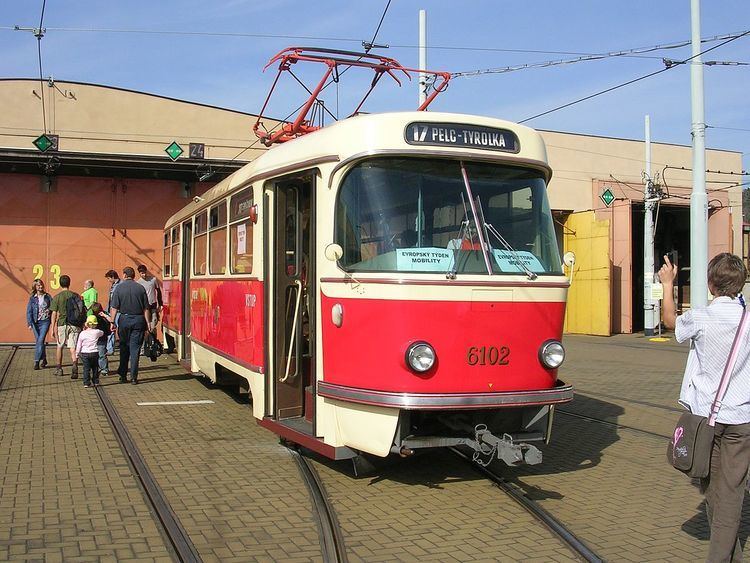Manufacturer ČKD Tatra Capacity 23 seats87 standing | Number built 14,113 Width 2,500 mm (8 ft 2 in) | |
 | ||
Constructed 1960–89, 1998–99 (T3RF) Train length 14,000 mm (45 ft 11 in) | ||
The T3 is a famous type of tramcar produced by Tatra. During its period of production, between 1960 and 1999, 13,991 powered units and 122 unpowered trailers were sold worldwide, mostly in Central and Eastern Europe and the Soviet Union. Well maintained tramcars of this type are very reliable, a late 2000s survey conducted in Prague tram system has shown 98.9% reliability, best of the Prague tram system fleet.
Contents
T3
The design of the T3 had to meet difficult specifications. The car should have the same capacity as its predecessor (the Tatra T2), but be easier to build. In order to achieve this goal for example the vehicle walls were thinner and were fitted with laminate seats instead of cushioned leatherette seats the T2 used. The T3 was delivered to all tramway companies in the former Czechoslovakia. It was most numerous in Prague, where over 1,000 vehicles were delivered. The T3 still forms (mostly in various modernised versions) the backbone of the Czech tram fleet.
T3SU
(SU for Soviet Union)
As with the T2SU the first T3SU was delivered with the modification of removing the middle door and replacing it with seats. Later cars, however, were delivered with the third door in place. Again the vehicles had a closed operator's compartment and were adapted for the harsh climate. Altogether 11,368 T3SU were delivered, making it worldwide the largest production of a single type of streetcar. But because so many of one type were made, their replacement by more modern cars was slow.
The T3SU was delivered from 1963, first to Moscow and later to 33 further Soviet cities.
T3SUCS
(SUCS for Soviet Union-modified Czechoslovakia)
Originally the production of the T3 was stopped 1976 and production was concentrated on newer vehicles. The Slovak city Košice, however, ordered two motor coaches, as an exception. Starting from 1985 the production of the replacement type KT8D5 should start, however this was by then obsolete. Further production of T3 would have been too expensive, so instead vehicles of the type T3SU were re-imported and adapted. The closed operator's cab was maintained, the vehicles had all three doors in place and differed from the original T3 only in few details. These vehicles can be, and sometimes are, formed into sets.
T3SU Evolution
Over time, the T3SU had minor changes in both exterior appearance and interior design.
Exterior details:
Interior:
T3D
(D for Deutschland)
In East Germany the first three T3D cars operated started operation in 1964 and 1965 in Dresden. The cars were used in part due to their width of 2.50 m (8 ft 2 in). They operated as single cars or as multiple units (Motor+Motor, Motor+Motor+Trailer) and/or as mini trams (Motor+Trailer). The use of trailer cars was due to the use of original Czech T3 electrical equipment, which had enough power to support trailer cars. However, due to reduced available power, the maximum speed of the streetcar reached only 55 km/h, instead of the usual 65 km/h (40 mph).
Only German and Yugoslav networks had trailer cars. The car was designated as B3D and had the same body as T3D. Today, only Chemnitz uses T3s in full service, having T3D-M (modified).
T3YU
(YU for Yugoslavia)
From 1967 onwards, vehicles supplied to Yugoslavia differed from the standard type T3 by having different pantographs and trucks. In addition, trailer cars were used, as in East Germany. Uncommonly, the network used narrow profile vehicles, like two in Czechoslovakia and one in the Soviet Union.
T3R
(R for Romania)
At the end of the 1960s, Romania ordered RA cars as part of an agreement in the Comecon. The first vehicles came in 1970 to the city of Galaţi and had different electrical equipment from the Czechoslovak vehicles, to use the network's 750 V DC voltage. Since the car boxes were built too wide for use elsewhere, they remain in Galaţi. Only 50 units were delivered.
A few more of the same type were manufactured in 1997.
T3RF
Four Tatra T3RF were the very last T3 trams built. They were made for Samara and Izhevsk, but only Samara bought them. In 2002 the two others were sold to Brno and modernized.
Modernized Tatra-T3 trams
In most Czech cities and in some others such as Bratislava, Moscow, Riga and Odessa, Tatra-T3 trams became very common. As a result, service and maintenance workers became very experienced them. This was one reason for modifying existing trams rather than replacing them with newer stock (the other being cost).
Modernization normally includes:
More radical modernization includes insertion of a low floor section.
Production
14,113 trams were produced and delivered to:
Note: This is the list of first owners. Stock may have later been resold to other cities not on this list.
